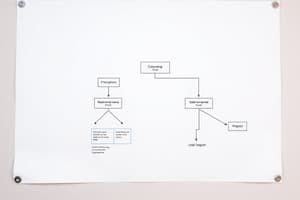Podcast
Questions and Answers
What is a sequence diagram?
What is a sequence diagram?
A Unified Modelling Language (UML) diagram that illustrates the sequence of messages between objects in an interaction.
What is a class diagram?
What is a class diagram?
Describes the attributes and operations of a class and also the constraints imposed on the system.
Why are class diagrams widely used in the modelling of object-oriented systems?
Why are class diagrams widely used in the modelling of object-oriented systems?
They are the only UML diagrams which can be mapped directly with object-oriented languages.
What does a sequence diagram consist of?
What does a sequence diagram consist of?
What does a lifeline represent?
What does a lifeline represent?
What does a lifeline show?
What does a lifeline show?
What does a message represent?
What does a message represent?
What is a synchronous message?
What is a synchronous message?
What is an asynchronous message?
What is an asynchronous message?
What is a message return?
What is a message return?
What is a creation?
What is a creation?
What is a destruction?
What is a destruction?
What is a found message?
What is a found message?
What is a lost message?
What is a lost message?
What are the main features of sequence diagrams?
What are the main features of sequence diagrams?
What are the main features of communication diagrams?
What are the main features of communication diagrams?
What is the main feature of interaction overview diagrams?
What is the main feature of interaction overview diagrams?
What is the main feature of timing diagrams?
What is the main feature of timing diagrams?
What is self delegation?
What is self delegation?
What does self delegation generate?
What does self delegation generate?
How is object deletion shown?
How is object deletion shown?
Sequence diagrams may be divided into areas. What are these areas called?
Sequence diagrams may be divided into areas. What are these areas called?
How many operands do combined fragments have?
How many operands do combined fragments have?
What do operators determine?
What do operators determine?
What do guard conditions determine?
What do guard conditions determine?
When does execution occur?
When does execution occur?
Flashcards are hidden until you start studying
Study Notes
Sequence Diagrams
- A sequence diagram is a UML diagram that shows the order of messages exchanged between objects during an interaction.
- It consists of lifelines representing objects and messages exchanged over time.
- A lifeline indicates participation in an interaction, while a message represents communication between lifelines.
- Synchronous messages require the sender to wait for the receiver to complete, while asynchronous messages do not wait.
- A message return shows control returning to the sender after a synchronous operation is completed.
- Creation signifies that the sender initiates a target, while destruction indicates that the sender removes the receiver.
- Found messages originate from outside the interaction's defined scope, while lost messages fail to reach their intended destination.
- Main features include the emphasis on time-ordered sequences, expressing rich interactions without explicitly showing object relationships.
Class Diagrams
- Class diagrams describe attributes, operations of a class, and system constraints.
- They are crucial for modeling object-oriented systems as they map directly to object-oriented programming languages.
Communication Diagrams
- Communication diagrams focus on structural relationships between lifelines and make object relationships explicit.
Interaction Overview and Timing Diagrams
- Interaction overview diagrams illustrate how complex behaviors result from simpler interactions.
- Timing diagrams emphasize real-time aspects of interactions.
Self Delegation and Object Deletion
- Self delegation occurs when a lifeline sends a message to itself, generating a nested activation.
- Object deletion is depicted by terminating a lifeline's tail with a large "X" at the deletion point.
Combined Fragments
- Sequence diagrams can be divided into areas known as combined fragments, containing one or more operands.
- Operators in combined fragments determine the execution process, while guard conditions decide operand execution based on their evaluation to true.
Studying That Suits You
Use AI to generate personalized quizzes and flashcards to suit your learning preferences.




